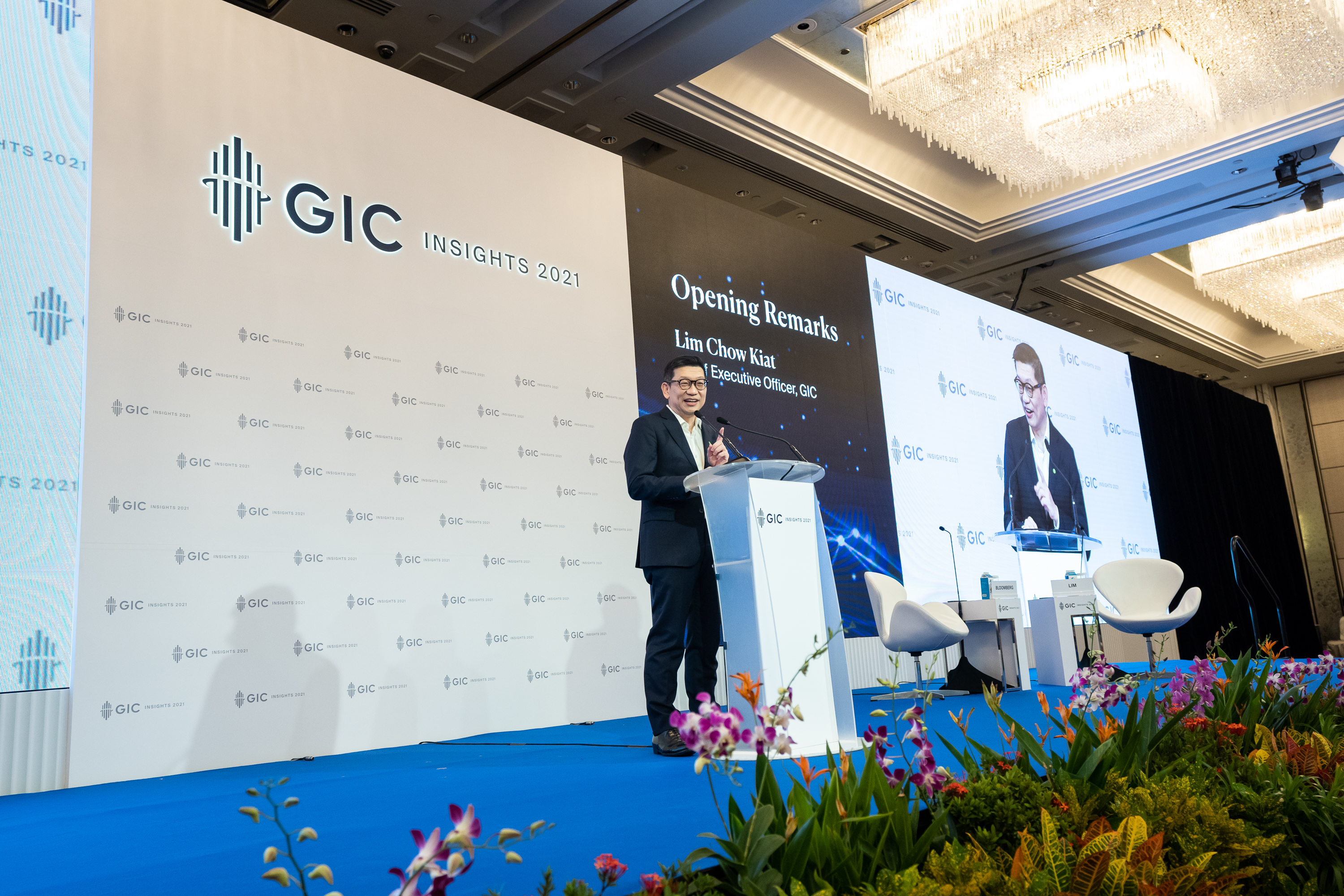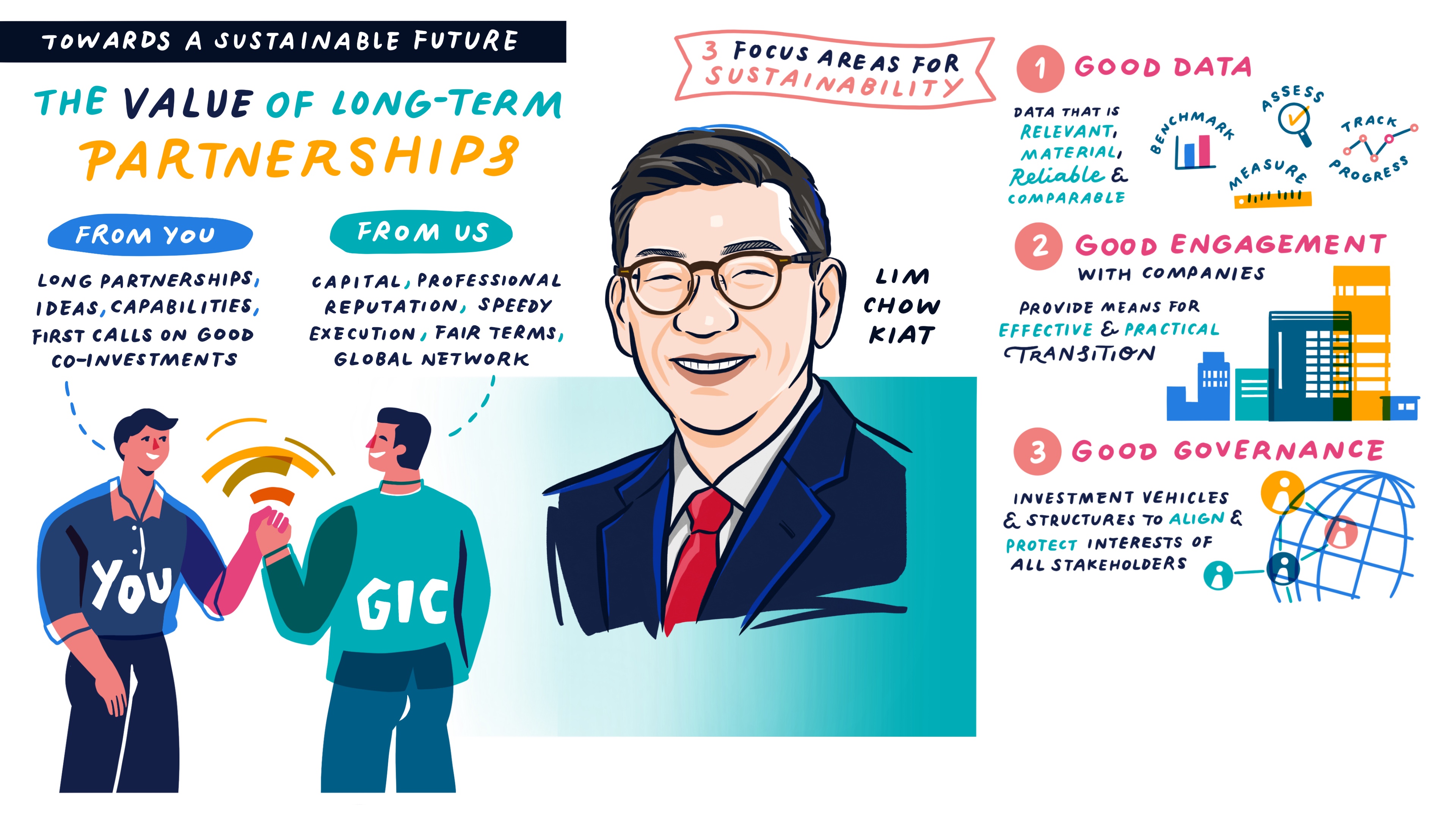This is an edited transcript of GIC CEO Lim Chow Kiat’ s opening remarks at GIC Insights 2021.
A very warm welcome to GIC Insights!
The value of this forum comes in large part from the network effect. Your individual participation, in-person or online, add disproportionately to that effect. This is platform investing – the value expands and compounds exponentially even without adding more capital. This compounding effect happens over time too. Albert Einstein reportedly called this “the most powerful force in the universe”. It fits right into how GIC invests – finding and holding assets with quality earnings to compound over the long term.
- These assets include our long partnerships with many of you. Your ideas, capabilities and giving us first calls on good co-investments are a big part of this compounding effect.
- I hope you would agree that we too contribute to your compounding, by providing you with good capital, professional reputation, speedy execution, fair terms, and a global network like what you see today. The compounding goes both ways.
At this forum, we will explore how we can use this universal compounding force to move “Towards a Sustainable Future”, the theme of this forum. Our distinguished speakers will share their insights with us on several topics.
- On a low-carbon economy, we will explore planetary challenges and solutions.
- On healthcare, we will get ideas on better care and affordability.
- On economies and policy, we will better understand if we are finally facing the trade-offs between growth and inflation.
In the next few minutes, let me talk briefly about what GIC is doing in terms of sustainability, using climate change as an example.
Climate risk is something we cannot diversify or divest away. It is an existential threat, a universal risk cutting across every asset class, and there is not enough capacity in green assets to find refuge in or address the problem. Divesting to pass on the problem to others is not a good solution. So instead, we embrace the transition, which means helping companies reduce their carbon emissions and deal with climate risks.

“Climate risk … is an existential threat, a universal risk cutting across every asset class, and there is not enough capacity in green assets to find refuge in or address the problem.”
As we do so, we have found these three needs:
First, we need good data, including taxonomy and disclosure standards.
- Getting data which is relevant, material, reliable and comparable is important to measure, benchmark, assess and track transition progress. Big advancements had been made by institutions such as the Carbon Disclosure Project (CDP) to collect carbon emissions data from companies, and the Taskforce on Climate-related Financial Disclosures (TCFD) with its emphasis on forward-looking scenario analysis.
- More recently at COP26, with the launch of the International Sustainability Standards Board (ISSB) we finally have a quicker way to get connectivity and compatibility between accounting and sustainability disclosure standards.
- In addition, there are also attempts at using new technologies such as artificial intelligence to help with surveillance. Things are looking up.
Second, we need good engagement with companies.
- During the transition, there are often inherent conflicts amongst the “E, S, and G”. This is especially so in developing countries where the transition need is the biggest and yet the resource constraint is the most severe.
- For example, cancelling a fossil fuel project, which could be the main source of livelihood for a local community, could be positive for the environment, but could indirectly reduce access to jobs, healthcare or education and even women’s rights. Or it may show up in the form of energy shortage, as seen currently.
- Good engagement comes from having a strong understanding of the bottom-up fundamentals and providing the means for an effective and practical transition.
Third, we need good governance.
- As is often said, there is money ready to be deployed, in trillions. But what is lacking are investment vehicles and structures which align with and protect the interests of all stakeholders.
- Much like in public infrastructure, the reliability of regulations and governance standards varies across countries. It explains the persistent gap between supply and demand of capital in that space. Adding sustainability considerations makes it more complex, especially as more stakeholders are involved.
- We need more efforts and examples, including projects de-risked by governments and multilateral development agencies, credible surveillance of sustainability progress, and clear protection of legal rights.
We consider these needs as difficult tasks to tackle, rather than some insurmountable problems.
How is GIC tackling them?
On the first task of getting good data, we contribute ideas and investor perspectives to the efforts of various standard-setting organisations.
- For example, we participated in the World Economic Forum’s (WEF) initiative to develop a harmonised set of ESG metrics, and in the Singapore Green Finance Industry Taskforce’s work to develop a green taxonomy for Singapore-based financial institutions.
- In addition, we continue to contribute data, either directly by collecting emissions data for our real estate assets, or indirectly by collaborating with our fund managers on disclosures. Last year, we signed on to the CDP’s letter to over 3,500 listed companies in our public equities portfolio to improve environmental disclosures consistent with TCFD’s recommendations. When data is available, as investors, we are then able to integrate them and better account for transition-related risks and opportunities in the investment process.
- For instance, when carbon emissions data became more standardised a few years back, we were able to create an internal carbon dashboard to compare the carbon intensity of companies and conduct more granular carbon price stress tests.
On the second task of transition engagement, we have in place both top-down and bottom-up efforts.
- We have found it particularly important to do the bottom-up work well; to engage our portfolio companies sub-sector by sub-sector, and company by company. Each faces different challenges, dilemmas and timelines. An overly top-down push may risk a counterproductive outcome, including bluntly divesting to meet emission targets.
- In our bottom-up work, for instance, we found an opportunity to contribute development capital to repurpose legacy assets, turning pipelines for transporting natural gas into pipelines for carbon capture and hydrogen. Such repurposing greatly saves time over building new infrastructure.
- We work with fellow investors too. This year, together with 12 members of the Asia Investor Group on Climate Change (AIGCC), we launched the Asian Utilities Engagement Program to engage with utility companies in Asia. This is an important effort as Asian utilities are responsible for 23% of the world’s total carbon emissions.
- Finally, several of our investee companies are moving fast ahead. Our pure play renewable company in India, Greenko, has gone beyond provision of “standard” renewable energy to the grid to helping customers to decarbonise. In the Philippines, we are excited to be working with AC Energy to transition its portfolio to being coal-free by 2030.
On the third task of designing investment vehicles with good governance, we have faced more difficulties. Nevertheless, we do have some examples of success:
- First is our US$2 billion investment in Duke Energy Indiana, where the governance and legal frameworks in the State of Indiana give investors a clear and proven mechanism for investing in new energy sources. Through additional investments, we do not only turn a business “green”, but also earn a fair return on our invested capital.
- Next are our investments in new technologies such as geothermal energy, carbon capture and sustainable farming. With appropriate government support and research institution collaboration, we are finding more new solutions which are promising.
- We have also started to participate in carbon trading in the compliance markets to prepare for the all-important market-based solution. We need a good governance system to price externalities and carbon markets provide a way to do that. Carbon trading must, however, not divert efforts from cutting carbon emissions at source, and should contribute to the overarching goal of a low-carbon future.
Conclusion
Ladies and gentlemen, we must transition to a low-carbon economy. There is no other way. We cannot diversify nor divest away climate risk. We must embrace the transition. We have some difficult tasks at hand, including those of data, engagement and governance. But we can tackle them methodically.
We can tackle them with confidence, drawing inspiration from the speedy advent of Covid vaccines. What was supposed to take 10 to 15 years was done in less than a year. That changed the course of the pandemic and along the way produced some big investment returns.
We will also count on the universal compounding force of partnerships with you, so let us find more opportunities to work together.
I hope you find the sessions and takeaways from GIC Insights 2021 useful.
Click on “Save as PDF” to access the pdf version of the opening remarks.







